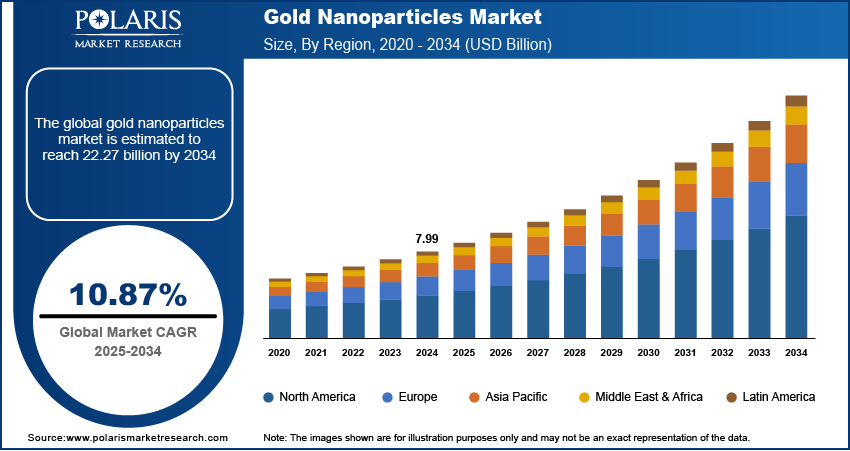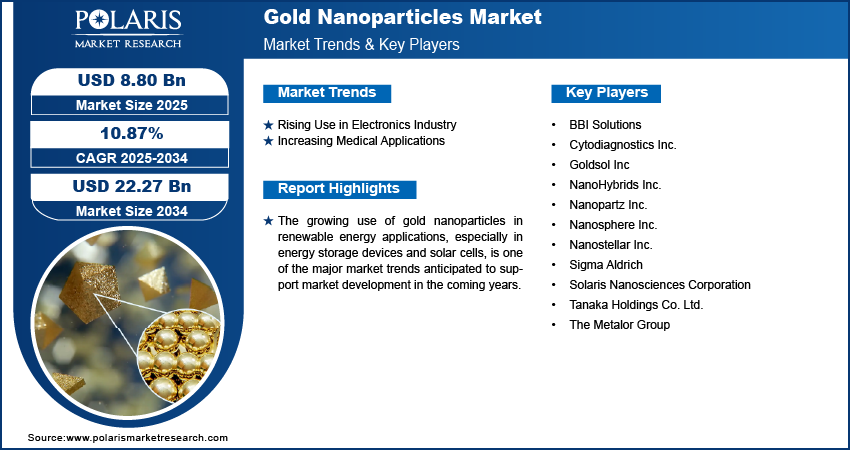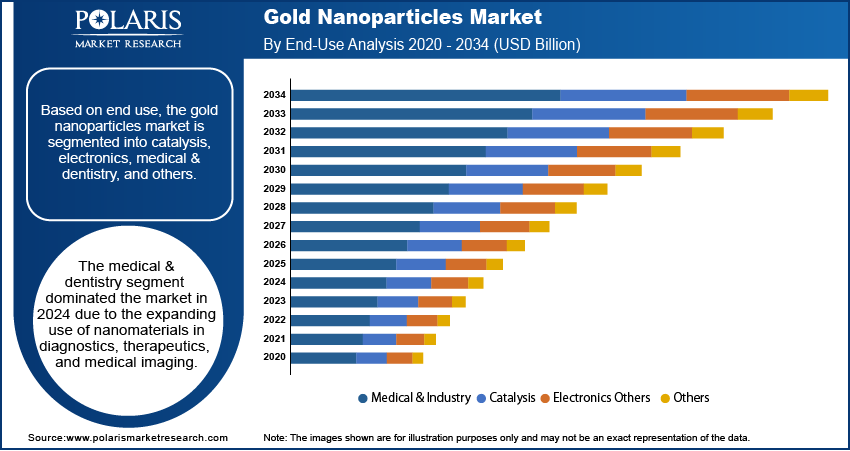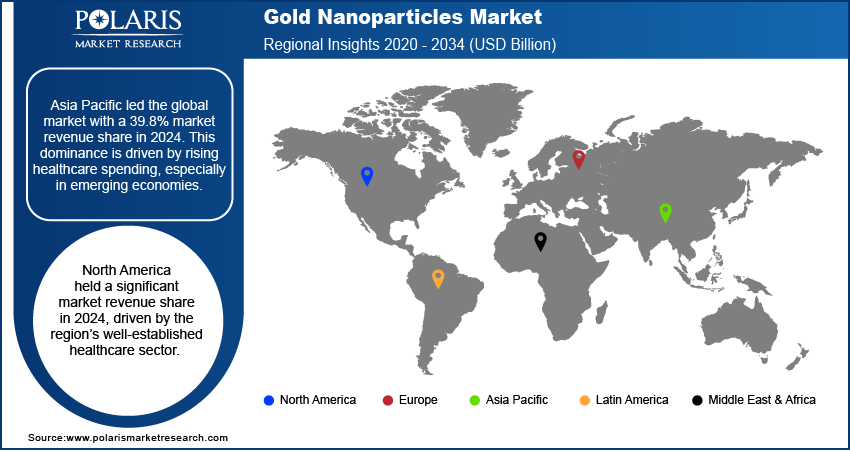
Gold Nanoparticles Market Size, Share, Trends, Industry Analysis Report
: By End Use (Catalysis, Electronics, Medical & Dentistry, and Others) and Region (North America, Europe, Asia Pacific, Latin America, and Middle East & Africa) – Market Forecast, 2025–2034
- Published Date:Aug-2025
- Pages: 119
- Format: PDF
- Report ID: PM1559
- Base Year: 2024
- Historical Data: 2020-2023
Market Overview
The global gold nanoparticles market size was valued at USD 7.99 billion in 2024 and is projected to register a CAGR of 10.87% from 2025 to 2034. High demand for nanotech products in diagnostics and the expanding application scope of gold nanoparticles are driving market demand.
Key Insights
- The medical & dentistry segment led the market in 2024, owing to the increased use of nanomaterials in therapeutics, diagnostics, and medical imaging.
- Asia Pacific accounted for the largest market share in 2024, primarily due to rising healthcare spending and growing investments in R&D across various sectors.
- North America accounted for a significant market revenue share in 2024 due to the presence of a well-established healthcare sector in the region.
Industry Dynamics
- The high versatility of gold nanoparticles, especially in electronics and catalysis, is fueling their increased use in the electronics industry and driving market growth.
- Rising investments in nanotechnology for targeted medicine and diagnostic imaging are driving market development.
- The growing focus on the use of gold nanoparticles in high-end cosmetic products is expected to create significant opportunities for market participants.
- Strict regulations regarding the use of nanoparticles may present challenges to market expansion.
Market Statistics
2024 Market Size: USD 7.99 billion
2034 Projected Market Size: USD 22.27 billion
CAGR (2025-2034): 10.87%
Asia Pacific: Largest Market in 2024

To Understand More About this Research: Request a Free Sample Report
Gold nanoparticles are tiny gold particles suspended in a liquid. These particles are inert and biocompatible and have low toxicity. Their diameter usually ranges between 3 and 200 nanometers. Gold nanoparticles are available in various forms, including nanospheres, nanoshells, nanorods, and nanocages.
The high demand for nanotech products in diagnostics, along with the growing use of nanoparticles in drug delivery systems, is driving the gold nanoparticles market growth. The continuous development of nanotechnology, which has expanded the application scope of gold nanoparticles in industries like energy, electronics, and environmental protection, further contributes to the market expansion.
The growing use of gold nanoparticles in renewable energy applications, especially in energy storage devices and solar cells, is one of the key trends anticipated to support market development in the coming years. Rising investments by governments, research institutions, and private companies to explore new use cases of gold nanoparticles are expected to create several gold nanoparticles market opportunities during the forecast period.
Gold Nanoparticles Market Dynamics
Rising Use in Electronics Industry
Gold nanoparticles have a significant surface area relative to their volume due to their ultra-lightweight and microscopic size. This unique property makes them highly versatile, especially in electronics and catalysis. Gold nanoparticle manufacturers are leveraging their small size for applications like electrical connectors, particularly through metallic nanotubes, which are lighter, more flexible, and smaller than traditional metal tubes. In the electronics industry, gold nanoparticles are also used to connect resistors, conductors, and other components of an electronic chip. Additionally, nanoparticles are employed in inks, nanowires, and electronic biosensors to assemble small storage devices. As electronic components become more miniaturized, the use of gold nanoparticles is growing, thereby contributing to the gold nanoparticles market development.
Increasing Medical Applications
The gold nanoparticles market is growing due to significant investments in nanotechnology for targeted medicine delivery, cancer treatment, and diagnostic imaging. In the medical field, gold nanoparticles offer several unique qualities, including powerful optoacoustic signals, high scattering capabilities, and excellent absorption with minimal interference of bone and tissue. These nanoparticles are employed in biosensors and bioimaging due to their special optoelectronic qualities and interaction with visible light. Their adjustable optical characteristics enable them to transform laser light into heat, selectively destroying malignant cells in photothermal cancer therapy. Additionally, nanoparticles have been successfully used to deliver nucleotide therapies. Their multivalency helps encapsulate unstable drugs or poorly soluble imaging contrast agents, enabling efficient delivery to areas of the body that would otherwise be difficult to target.

Gold Nanoparticles Market Segment Insights
Assessment by End Use Insights
The gold nanoparticles market, based on end use, is segmented into catalysis, electronics, medical & dentistry, and others. The medical & dentistry segment dominated the market with a 54% market share in 2024 due to the expanding use of nanomaterials in diagnostics, therapeutics, and medical imaging. In addition, the growing need for therapeutics and diagnostics based on nanotechnology has led to increased use of gold nanoparticles in medicine. Rising R&D expenditures for cancer-targeting nanoparticle technology and drug delivery systems further contribute to the segment’s leading share in the global market.

Regional Analysis
By region, the report offers the gold nanoparticles market insights into North America, Europe, Asia Pacific, Latin America, and the Middle East and Africa. Asia Pacific led the global market with a 39.8% market revenue share in 2024. This dominance is driven by rising healthcare spending, especially in emerging economies. The growing population and rising prevalence of lifestyle-related illnesses in the region have created new opportunities for gold nanoparticle-based therapeutic approaches. Their use in targeted therapies reduces the side effects of traditional treatments while increasing treatment efficacy. In addition, rising investments in R&D across multiple sectors, including materials science, pharmaceuticals, and electronics, contribute to regional market dominance.
North America held a significant market revenue share in 2024, driven by the region’s well-established healthcare sector. The rising prevelance of cancer and other chronic conditions has led to increased research in targeted drug delivery systems, where gold nanoparticles are used for their biocompatibility and unique optical properties. In addition, rising R&D expenditures are anticipated to support the regional market growth in the upcoming years.

Key Players and Competitive Insights
The market for gold nanoparticles is characterized by intense competition, driven by factors such as innovative product offerings, technological advancements, mergers and acquisitions, and other strategic partnerships. The key players in the market strive to differentiate themselves in terms of pricing, quality, offering, and customer service. Also, they are making significant investments in R&D initiatives to introduce advanced gold nanoparticles to cater to diverse consumer needs.
Several market participants are prioritizing the development of sustainable and eco-friendly gold nanoparticles that comply with stringent government regulations. The gold nanoparticles market research report offers a market assessment of all the leading players, including BBI Solutions, Cytodiagnostics Inc., Goldsol Inc, NanoHybrids Inc., Nanopartz Inc., Nanosphere Inc., Nanostellar Inc., Sigma Aldrich, Solaris Nanosciences Corporation, Tanaka Holdings Co. Ltd., and The Metalor Group.
List of Key Players
- BBI Solutions
- Cytodiagnostics Inc.
- Goldsol Inc
- NanoHybrids Inc.
- Nanopartz Inc.
- Nanosphere Inc.
- Nanostellar Inc.
- Sigma Aldrich
- Solaris Nanosciences Corporation
- Tanaka Holdings Co. Ltd.
- The Metalor Group
Gold Nanoparticles Industry Developments
In June 2024, researchers at Flinders University in South Australia created a variety of gold nanoparticles by modifying the flow of water in an innovative vortex fluidic device, eliminating the need for hazardous chemicals.
In March 2024, Rice University's Wiess School of Natural Sciences announced the launch of the Center for Nanoscale Imaging Sciences. The center aims to push the boundaries of nanoscale imaging by enhancing the analysis and interpretation of images at the nanometer scale.
Gold Nanoparticles Market Segmentation
By End Use Outlook
- Catalysis
- Electronics
- Medical & Dentistry
- Others
By Regional Outlook
- North America
- US
- Canada
- Europe
- Germany
- France
- UK
- Italy
- Spain
- Netherlands
- Russia
- Rest of Europe
- Asia Pacific
- China
- Japan
- India
- Malaysia
- South Korea
- Indonesia
- Australia
- Rest of Asia Pacific
- Middle East & Africa
- Saudi Arabia
- UAE
- Israel
- South Africa
- Rest of Middle East & Africa
- Latin America
- Mexico
- Brazil
- Argentina
- Rest of Latin America
Gold Nanoparticles Market Report Scope
|
Report Attributes |
Details |
|
Market Size Value in 2024 |
USD 7.99 billion |
|
Market Size Value in 2025 |
USD 8.80 billion |
|
Revenue Forecast by 2034 |
USD 22.27 billion |
|
CAGR |
10.87% from 2025 to 2034 |
|
Base Year |
2024 |
|
Historical Data |
2020–2023 |
|
Forecast Period |
2025–2034 |
|
Quantitative Units |
Revenue in USD billion and CAGR from 2025 to 2034 |
|
Report Coverage |
Revenue Forecast, Market Competitive Landscape, Growth Factors, and Trends |
|
Segments Covered |
|
|
Regional Scope |
|
|
Competitive Landscape |
|
|
Report Format |
|
|
Customization |
Report customization as per your requirements with respect to countries, regions, and segmentation. |
FAQ's
The gold nanoparticles market was valued at USD 7.99 billion in 2024 and is projected to grow to USD 22.27 billion in 2034.
The market is projected to register a CAGR of 10.87% during 2025–2034.
In 2024, Asia Pacific held the largest share of the global market.
BBI Solutions, Cytodiagnostics Inc., Goldsol Inc, NanoHybrids Inc., Nanopartz Inc., Nanosphere Inc., Nanostellar Inc., Sigma Aldrich, Solaris Nanosciences Corporation, Tanaka Holdings Co. Ltd., and The Metalor Group are a few of the key players in the market
The medical & dentistry segment dominated the market in 2024.
